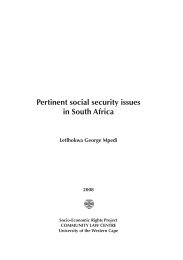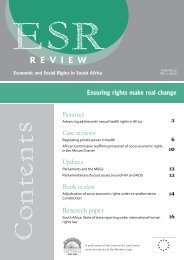the ages of 15 and 17. In an emergency, social workersare brought <strong>in</strong> from one of the other prisons.At Pretoria Central Medium B, there are two socialworkers allocated to the section, and the juvenilesalso have access to the five or six psychologists whoserve the entire prison complex of about 5 000 prisoners.At Pietermaritzburg, researchers were told that socialwork services were provided by Correctional Services'and that the needs of juveniles were catered for.At Pollsmoor Medium A Section for sentenced juveniles,one social worker deals with the 327 juveniles(<strong>in</strong>clud<strong>in</strong>g 21 children under 18). She reported thatshe <strong>in</strong>terviewed each juvenile on his arrival and,from this, was able to assess his needs.under the age of 21 (50 under the age of 18f at Westville.The researcher commented on the shortage of social workstaff. The social worker <strong>in</strong>terviewed reported that shewould like to work with parents, especially at the prereleasestage, but that they were generally not responsive.She had also tried to refer families to other agencies butthese referrals were not followed up. With more staff, shesaid she could run therapy groups with all sentencedjuveniles, visit their families at home, and prepare familiesto receive the young person when he was released.There are two social workers and one social workstudent at the Westville Youth <strong>Centre</strong> for an average of200 2 unsentenced and await<strong>in</strong>g trial boy children underthe age of 18. NICRO sends one additional person tohelp one morn<strong>in</strong>g a week. The two social workersprofessed to be under great pressure and said that theycould not provide the necessary supervision dur<strong>in</strong>g therecreation period as they had children to <strong>in</strong>terview andcould not do everyth<strong>in</strong>g. At this facility, the socialworkers were clear about the need for child care workersto supervise the children, as well as more social workersto follow up court cases and undertake <strong>in</strong>dividualtherapeutic work. If staff were provided, they said, theywould be able to concentrate on therapeutic work.At the time of the visit, neither a social worker nor apsychologist was employed at the Westville Women's<strong>Prison</strong>. The prison population was 300, with fivesentenced and three unsentenced children betweenWhat the children sayEven where there are social workers, the children oftensaid that they were either unaware of their existenceor had never spoken to them. At Johannesburg MediumA, await<strong>in</strong>g trial and unsentenced prisoners said theyhad never seen a social worker <strong>in</strong> their lives. They were,<strong>in</strong>deed, not aware that they were entitled to ask to seea social worker if they needed assistance. At St Albans,there were two social workers employed at the prison,one of whom worked with the juveniles. However, onlyone of the twelve children <strong>in</strong>terviewed reported thathe had met with a social worker, say<strong>in</strong>g that he hadasked to meet the family of his victims to apologisefor what he did. He had allegedly been sentenced totwo years imprisonment for murder and robbery.In Thohoyandou Female <strong>Prison</strong>, researchers were toldthat the social worker had visited the cell <strong>in</strong> which thejuveniles were held only once <strong>in</strong> order to check thebabies. The children await<strong>in</strong>g trial, of which there weretwo at the time, were not spoken to, despite the factthat one of them was a 17 year bid orphan who hadher own baby with her <strong>in</strong> prison.Assistance with contact<strong>in</strong>g familiesMore often than not, the children are preoccupiedwith the need to get <strong>in</strong> touch with their families.9 This average refers to the period November 1996 to April 1997. This number represents an <strong>in</strong>crease* from theAugust to October 1996 average of 120 - 140 and, by the end of April, the averages were between 230 - 245.©VIOLENCEIN PRISONS
At Barberton <strong>Prison</strong>, at which there were only sentencedchildren at the time of the visit, a social worker visitsthe prison three morn<strong>in</strong>gs a week and runs onegroup a'week. There were programmes on life skills,HIV education and an eight-week sexual offendersprogramme. She also reported that she attended to<strong>in</strong>dividual requests and compla<strong>in</strong>ts and occasionallygave <strong>in</strong>dividual counsell<strong>in</strong>g. She confirmed that thepredom<strong>in</strong>ant concern of the children was mak<strong>in</strong>gcontact with their families.As at other <strong>in</strong>stitutions, the children at Barbertonwere very concerned that they had not been visited,that their families were far away and that, <strong>in</strong> somecases, their families did not even know they were <strong>in</strong>prison. It emerged <strong>in</strong> the report on this <strong>in</strong>stitution thatall the children <strong>in</strong>terviewed had been liv<strong>in</strong>g at homeprior to their arrest. They were thus presumably <strong>in</strong> aposition to furnish <strong>in</strong>formation about the whereaboutsof their families.At Westville, as elsewhere, most of the children'srequests related to contact<strong>in</strong>g their families and, <strong>in</strong>the case of await<strong>in</strong>g trial children, to f<strong>in</strong>d<strong>in</strong>g outabout their court cases. At this facility, the socialworkers said this meant 30-40 phone calls a day,leav<strong>in</strong>g little time for therapeutic work.The social workers at Westville Youth <strong>Centre</strong> reportedthat they were very understaffed and could not keeptrack of so many children at once. Psychological carewas only available for sentenced children, and therewas no <strong>in</strong>dividual assessment or group therapeuticprogramme for await<strong>in</strong>g trial children.The researchers were told at Barberton that the socialworker did not attend to the cases of unsentencedjuveniles because these were the responsibility of thedepartments of Health and Welfare. They were also toldthat the social worker seldom visited the prisoners at theprison. Indeed, the children <strong>in</strong>terviewed at Barbertonsaid they had never attended a social work programme,nor had they ever been seen by a social worker.At Leeuwkop Medium B <strong>Prison</strong>, there were two full timesocial workers <strong>in</strong> the juvenile prison, with a-case loadof twenty <strong>in</strong>mates at any one time. There were 785sentenced juveniles <strong>in</strong> the prison, of which 106 werechildren. As at other <strong>in</strong>stitutions, most of the problemsrelated to family contact and relationships with families.The social workers here also assist <strong>in</strong> secur<strong>in</strong>gma<strong>in</strong>tenance grants for prisoners with children.However, at this prison, a negative stigma is attachedto seek<strong>in</strong>g assistance from the social workers, andfew of the prisoners <strong>in</strong>terviewed had had contactwith the social- worker.At Stanger <strong>Prison</strong>, where researchers found 3await<strong>in</strong>g trial and one sentenced child on the day ofthe visit, there was no social worker for the juveniles.Social workers are provided by Correctional Servicesbut seemed only to attend to matters relat<strong>in</strong>g tocorrectional supervision or parole.Medical Staff"Every detention facility for juveniles should haveimmediate access to adequate medical facilitiesand equipment appropriate to the number andrequirements of its residents and staff tra<strong>in</strong>ed <strong>in</strong>preventive health care and the handl<strong>in</strong>g of medicalemergencies. Every juvenile who is ill, who compla<strong>in</strong>sof illness or who demonstrates symptoms of physicalor mental difficulties, should be exam<strong>in</strong>ed promptlyby a medical officer. " (UN RULES, hi)Most prisons appear to have a small component ofmedical staff, usually a qualified nurse who may run acl<strong>in</strong>ic, as is the case at Rustenburg <strong>Prison</strong>. In some<strong>in</strong>stances, such as at St Albans, the nurse does a dailyround of the juvenile cells. At Pollsmoor Medium A,rounds are done three times a week. At the Westville -Youth <strong>Centre</strong>, the nurses take a trolley down to thed<strong>in</strong><strong>in</strong>g room corridor at breakfast time. At Leeuwkopthree full time nurs<strong>in</strong>g staff are employed, and a doctorvisits the prison twice a week. A dentist also visits oncea week.At the Westville Youth Centré, there are two nurses onduty dur<strong>in</strong>g the day and one at night, The night dutynurse serves the entire population of the prison whichconsists of several thousand people. There is also adoctor and a part time district s.urge'on on call at night.A doctor also visits twice a week and the children arereferred to him if they need attention. In the WestvilleWomen's <strong>Prison</strong>, there is a nurse about whom all theprisoners compla<strong>in</strong>ed. (See under How the <strong>Children</strong>,are Cared For (pg 28) medical treatment section).
- Page 2 and 3:
• ContentsINTRODUCTION 1ACKNOWLED
- Page 4 and 5:
almost certainly because they tear
- Page 6 and 7:
Figure 2 gives a breakdown of child
- Page 8 and 9:
THANKS ARE DUE TO:The children and
- Page 10: .Ekuseni Youth CentreThe Ekuseni Yo
- Page 13 and 14: 1• Definition of Children andJuve
- Page 15 and 16: age of 18 with their own age groups
- Page 17 and 18: Dedicated facilities for JuvenilesT
- Page 19 and 20: At the Pollsmoor Admission Centre,
- Page 21 and 22: Separation of sentenced and unsente
- Page 23: Beds and bedding"Every juvenile sho
- Page 26: At Pietersburg, the researcher was
- Page 29 and 30: are virtually unoccupied for long p
- Page 31 and 32: At Rustenburg, a qualified, nurse i
- Page 33 and 34: At Pretoria Central, a new prison,
- Page 35 and 36: offers them a 'good opportunity of
- Page 37: The South African Constitution ensh
- Page 40 and 41: Leeuwkop were extremely demotivated
- Page 42 and 43: trial- are the responsibility of th
- Page 44: Where programmes are jn placeIn som
- Page 47: At Westville Youth Centre, there is
- Page 50 and 51: VIOLENCE IN PRISONS
- Page 52 and 53: AssaultAs part of their mission sta
- Page 54 and 55: of 24, sometimes without even a tel
- Page 56 and 57: "Personnel should be qualified and
- Page 58 and 59: the night at 3pm. In some instituti
- Page 62 and 63: Generally, serious problems are ref
- Page 64 and 65: Alternatively, if a charge is to be
- Page 66 and 67: One of the consistent patterns that
- Page 68 and 69: Often children say that they are, n
- Page 70 and 71: the names of their lawyers. Three o
- Page 72 and 73: Bail"Every child has the right not
- Page 74 and 75: Postponements and finalisation of c
- Page 76 and 77: Figure 7 shows the length of senten
- Page 78 and 79: How the Children are Cared For8. An
- Page 80: Trial40. Parents or guardians shoul
















